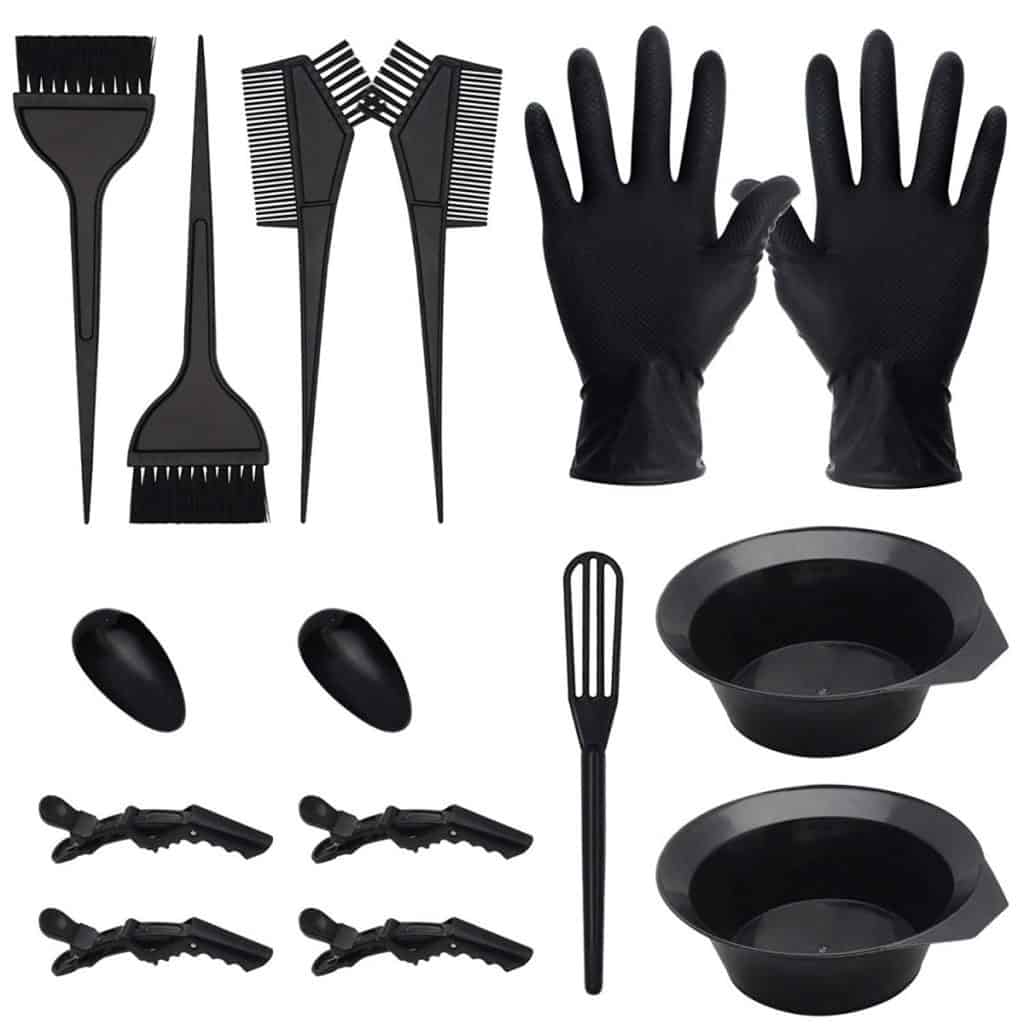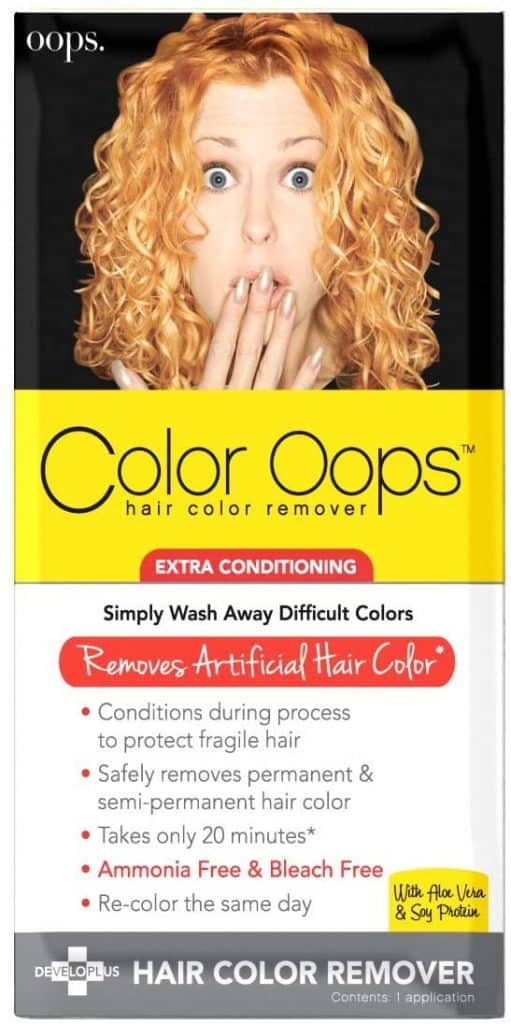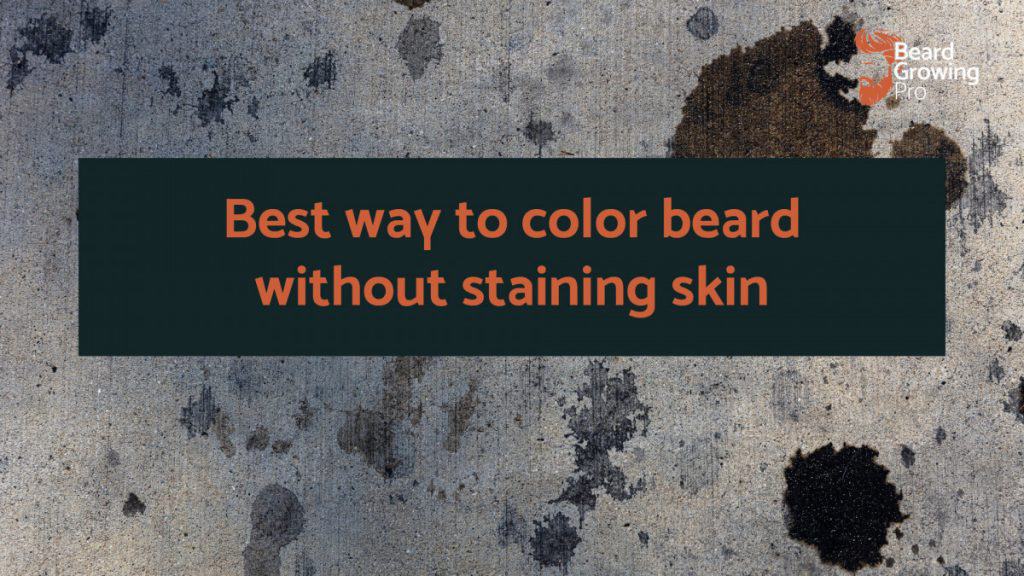Dying a beard is a fantastic way to keep it looking thick, dense, and to create an impression of a substantial beard. Some people like to do it to cover-up greys and, if you have multiple colours in your beard, some people use it just to create a single colour beard. The problem with beard die is that it stains anything that it touches. Even the slightest drop of beard die on your skin can leave a relatively dark patch. In this article, we’re going to talk about the best way to colour your beard without sustaining the skin and all of the tips and tricks for doing it simply.
The best way to colour your beard without staining the skin is to use the barrier method such as Vaseline, thick moisturising cream, or lip balm to creating a waterproof barrier between your skin and the dye. You can use hair clips to hold your beard off your neck and chest if your beard is long.
While you are using a beard die there are plenty of areas that you don’t want it to touch. This includes your cheekline, your neckline, your ears and lips.
Here are all of the best ways that you can keep your skin stain free whilst colouring your beard with dye.
Use gloves
When you are dying your beard your first line of defense when mixing, applying, and distributing the dye throughout your beard are gloves. Gloves provide a physical barrier between you and the dying component of the mix.
A lot of beard dies come with relatively cheap and ineffective plastic gloves which can easily get holes in them along the seams and punctured by various beard grooming tools such as hard plastic combs.
If you are dying your beard regularly, I recommend that you get yourself some professional hair dye gloves which can be reused over and over again. Some of the best gloves on the market are these from the brand IXIGER:

These have been specially designed for salon use which means they will be up to the job for your home dying adventures. The gloves are incredibly thick so that they do not crack, and they withstand multiple re-uses. All you have to do is simply wash them with water or a small amount of isopropyl alcohol diluted in water for reuse. If you are concerned about the environmental impact of using disposable gloves a pair like this would be perfect to minimize your guilt and anxiety.
Use the right tools
Another really important aspect of applying beard die to your beard without getting on your skin is to use the appropriate tools. I’ve been there and thought – I’ll just use my regular comb. This has been incredibly detrimental to the effectiveness of the dying treatment and also it has been much messier.
Buying the right tools which include a variety of combs, brushes, mixing spoons and bowls – as well as ear covers – means that you are able to apply the beard die much more accurately than with a single brush and your hands.
A great kit that is currently on Amazon is the 15 piece hair dying colouring kit that you can use for your beard.

A group of tools like this one contains everything you need to apply your beard dye like a professional. A kit should contain a mixing bowl, hair colouring brushes, hair dye combs, plastic ear caps, a pair of gloves, and a mixing spoon.
The combs and the brushes will allow you to apply beard dye to your beard accurately and with minimal accidental overshooting of your highest beard growth density.
If you are regularly colouring your beard this is a no-brainer for giving you the best opportunity to keep the colour of your skin. It all starts with accuracy of application.
Old T-shirt
If you have a particularly long beard, or you find that beard dye regularly drips onto your chest I’d recommend using an old T-shirt every time that you dye your beard.
While you are moving your head around – while you’re waiting for the dye absorb – there are plenty of opportunities for your beard to rub against your neck, and shoulders when you look to the side.
Wearing an old T-shirt creates a physical barrier between your chest and the dye as it sits in your beard.
Wipe off as soon as possible
One of the most effective ways of stopping your skin from becoming stained is to wipe off the dye as soon as it lands on a place where it shouldn’t.
When you are dying your beard you should keep a series of cotton wool pads, an old towel, and some dilute isopropyl alcohol nearby so that you can jump onto the splashes and spills as soon as they happen.
If you are quick enough a simple dam with water may be all you need to quickly remove the spill overs.
If you do not want to dry out your skin with dilute isopropyl alcohol solutions and you are finding that water is not removing it as effectively as you would hope you could use a moisturising baby wipe which are great for people with sensitive skin. They do not leave any residue and are tough on stains.
Barrier method
Prevention is better than cure and making sure that no beard dye ends up on places it shouldn’t be in the first place is your best option and it only takes a little bit of planning to avoid hours of scrubbing dye off of your cheeks.
There are whole range of water repellent barriers that you can put on your skin including Vaseline, thick moisturising cream, and lip balm. Let’s take a little look at each of these now.
Vaseline
Vaseline is an American brand of petroleum jelly-based products. It is owned by the British-Dutch company Unilever. It is regularly used for skin conditions that are associated by tissue dehydration and smaller pots are used to protect against chapped lips and dryness of the lips. Although, you can use any form of petroleum jelly to stop the beard dye from absorbing into your skin.

Vaseline is a petroleum-based product and was discovered in 1859. A gentleman called Robert Chesebrough went into the oil fields of Pennsylvania and learned about a residue called “Rod wax” that had to be removed from oil rig pumps. The oil workers used to use this to their advantage and had been using it to heal cuts and burns. Robert took samples of this strange residue back to Brooklyn with him where he was able to extract usable petroleum jelly and therefore isolated the key component of a medicinal product that he called Vaseline.
Besides its cosmetic and therapeutic use it can be used to stop water based products from entering the pores and seeping into your skin.
Thick moisturising cream
You can also opt for a thick moisturising cream to stop the dye from staining your skin.
The moisturising cream should be put on relatively thick so that it does not absorb completely over the time that you are dying your beard.
Not only does it provide a physical barrier to the dye but it also seeps into your pause and skin so that there is less chance and opportunity for the dye to do the same.
If you find that Vaseline, or other petroleum-based product, is irritating your skin or causing you to have a reaction using your favourite thick moisturising cream will not only protect you against the odd stain but it will also leave the skin in a better condition.
Lip balm
Many people use lip balm throughout the day. You can also use lip balm on the areas that you do not want beard dye to stain.
Lip balm is a wax or petroleum-based product which can soothe your lips and the outer layer of skin by moisturising and protecting from environmental factors such as UV rays and wind.
The reason people use them is because the lips have no natural oil glands in them and so often dry out quicker than other parts of the skin.
This can be exacerbated by licking which means that the petroleum jelly used in lip balm has been formulated especially to be water resistant. Choose a lip balm that does not have any strong flavours or smells to them to make sure that you do not have a reaction to any of the ingredients but also that the dye does not interact with any of the flavour or smell additives.
Beard balm (with wax)
You can also use your beard balm or beard wax to provide a waterproof barrier against the beard dye. Just make sure that the beard balm contains wax which will be persistent on your skin during the dying process. You could use a beard butter but it is likely that the butter would absorb into your skin before you get a chance to finish the dying process.
Quite often, and in my very own DIY beard balm, people use beeswax or another organic wax to provide hold and shine to their beards. That same product will also provide a physical waterproof barrier against your dye.
Simply rub it along the areas of your cheek, ears, neckline, lips, and moustache where you do not want the dye to go.
Use hair clips
Lastly, you should consider using hair clips to hold your hair away from certain parts of your neck, chest, ears, or nose – if you have a big fancy moustache.
Quite often, with beard dyes you have to do sit for up to one hour with the beard dye in your beard. During this time there is potential for your beard to rub up against a number of other body parts.
Using a hair clip – if your beard is long enough – will hold the beard hair in place and away from anything in close proximity to the dye. Make sure that you use a plastic hair clip or a hair clip that is not affected by the chemicals used in the beard dye as it could change the colour where the clip is set against the hair.
Removing stains
If you have managed to get through your beard dying session but you still have got a little bit of beard dye on your skin – don’t worry – there are options for removing stains from your skin even if you have allowed the dye to sit for up to one hour on places that you don’t want to colour.
IPA
One of the most effective ways that you can remove beard dye which has landed on your skin is to use isopropyl alcohol. If you find isopropyl alcohol dries out your skin too much you can water it down with a small amount of tap water.
Simply damp the isopropyl alcohol onto a cotton small for clean towel and dab the areas that you want free of dye. Repeat with clean swabs and towels until all of the colour has been removed and you are happy with the result.
Isopropyl alcohol is fantastic at cleaning up natural grease and see them from your skin so use cautiously and wisely. Make sure that after you have applied isopropyl alcohol to an area that you back it up with a moisturising product to protect the skin.
Toothpaste
Toothpaste contains small abrasive particles which can help remove beard dye from the skin. All you have to do is grab a clean toothbrush or a clean cloth and apply a non-gel toothpaste.
You can repeat this process until the marks are fully gone and you have two use with caution as the abrasive nature of toothpaste can easily cause irritation and redness to the top layer of your skin.
Olive oil
You can also use olive oil to remove any dye from your skin. Slightly increasing the temperature of the olive oil may work a little bit better. You can simply heat up half a cup of olive oil on the stove or in the microwave for approximately 10 seconds. Wet the area before applying the warm olive oil and allow it to sit there for a couple of minutes.
If you find that this doesn’t work you can mix the olive oil with equal parts vinegar for a more harsh removal of the beard dye.
Nail polish remover
Nail polish remover isn’t something that you should use as a first resort for removing beard dye from your skin. The primary ingredient is acetone which can very easily dry out your skin and cause irritation.
Acetone can be used in woodworking to remove stains from wood and leather work. It is relatively inexpensive but because of its power it needs to be used sensibly if you are going to put it on your skin.
Keep it away from anywhere close to your eyes and I’d recommend only using it on your neckline and ears if you must. Even placing it on my cheeks – close to my eyes, is too close for comfort for me.
Make up remover
Make up remover has been especially formulated to remove persistent chemicals from the skin.
There is a constant battle between making sure that make up stays on the skin for as long as possible but also that it can be removed easily. Make up remover is the ultimate cream and solution for removing persistent stains from lipsticks and other cosmetics – this makes it perfect for use on your beard dye.
Not only has make up remover been formulated to be harsh on these chemicals it has also been balanced so that it can be used on your skin and close to your eyes.
Simply purchase some make up remover from the pharmacy and place it on a clean cotton swab or clean towel and rub lightly in small circular motions until the offending dye has been removed.
Stain remover
You can also use products which have been formulated for removing hair dye from hair. There are plenty of options and one of the best is the Color Oops hair colour remover.

Even though it is formulated for use on hair it will also work just as well on your skin as long as you do not leave it against the skin for as long as it recommends you leave it in hair.
Summary
In this article, we have been through all of the best ways to colour your beard without sustaining it. Remember that prevention is better than cure and you can use a series of physical barrier methods. Being the beard dye getting on your skin such as wearing an old T-shirt, using good quality gloves that do not break, using a waterproof barrier such as petroleum based products and beard balm, and physically holding the beard away from your skin with hair clips.
Making sure that you purchase the right tools for doing a good job at all of the intricate angles and areas of your beard will ultimately allow you to apply the beard dye with minimal error.
This includes purchasing the right beard application brushes and combs.
Luckily, if you do get some beard dye on your skin it can be easily removed with a series of commonly available ingredients and products. Even if you have sensitive skin there will be a product in this article which you can use to remove beard dye from your skin without causing significant irritation.



